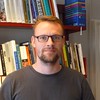 A couple of weeks ago, I was asked to contribute to a workshop on interdisciplinarity and ageing research, organised by Lene Otto and the humanities section of the Center for Healthy Aging here in Copenhagen on Wednesday 14 December.
A couple of weeks ago, I was asked to contribute to a workshop on interdisciplinarity and ageing research, organised by Lene Otto and the humanities section of the Center for Healthy Aging here in Copenhagen on Wednesday 14 December.
Why interdisciplinarity? Well, the Center is pretty big — about 150 biomedical scientists, epidemiologists, health service researchers, ethnologists, etc., plus a few communication scholars here at Medical Museion — and the problem of knowing what the others in the Center are doing (not to mention trying to work together) is something this Center shares with many other multidisciplinary research institutions.
So to inspire and strengthen interdisciplinarity within the Center, Lene Otto has invited Durham-based sociologist Tiago Moreira to stay with us for a year — and this workshop is an appetiser for what he will try to achieve in the months to come.
Tiago probably doesn’t know much about science communication in museums, so here’s where I come into the picture. My contribution to the workshop will be to suggest that making museum exhibitions is an excellent pragmatic route to foster interdisciplinarity.
My (so far rather speculative!) idea is quite simple:
When speaking and writing on the basis of research texts, scientists and scholars tend to stay close to their disciplinary traditions. The research text (published papers, posters, power presentations, research proposals, etc.) is a manifestation of disciplinary entrenchment. Each word, each phrase, derives its meaning from a given disciplinary context. Furthermore, there is rarely a common always-already interdisciplinary text on the table to be interpreted; instead, each scientist/scholar throws his/her own text into the circle. As a consequence, when scientists and scholars meet on the basis of their texts, interdisciplinarity (and cross-disciplinarity) becomes an uphill struggle.
Images and material things, on the other hand, are not as easily co-opted into disciplinary discourses. Both images and artefacts are open to a much more varied range of interpretations than texts are. Material artefacts, especially, are curiously resistant to disciplinary reductions. When scholars and scientists meet around material artefacts, the presence of the object invites to interaction.
The consequence of this line of reasoning is that the involvement of scholars and scientists in curatorial tasks and exhibition-making might facilitate cross-disciplinarity better than text-based interaction. Selecting, curating and making sense out of material objects and putting material things together in meaningful three-dimensional arrangements in order to engage the public might, I suggest, be highly conducive for cross-disciplinary thinking and practice.
Does this make sense? I’ve got two and a half week to work out the idea — if you have some good arguments pro or con, please let me know.
And by the way, here’s the preliminary programme for the workshop:
- Tiago Moreira, ‘Gerontology and changing conceptions of inter-disciplinarity’.
- Thomas Söderqvist, ‘The exhibition as a cross-disciplinary interface between scientific research and public engagement’.
- Group discussions on barriers and facilitators of cross-disciplinary collaboration in the study of ageing
It takes place on Wednesday, 14 December, between 10 am and 1 pm. The venue and the final programme will be announced here soon.


 We have written about biomedical containers in different context. For example, it was a fascination with organ transportation boxes that partly laid behind our former senior curator
We have written about biomedical containers in different context. For example, it was a fascination with organ transportation boxes that partly laid behind our former senior curator  And, of course, containers loomed large in the “container wall” designed by Martha Flaming, which helped Medical Museion win the Dibner Award for Excellence in Museum Exhibits for the Split and Splice Exhibition (see
And, of course, containers loomed large in the “container wall” designed by Martha Flaming, which helped Medical Museion win the Dibner Award for Excellence in Museum Exhibits for the Split and Splice Exhibition (see  Hør vores egen
Hør vores egen